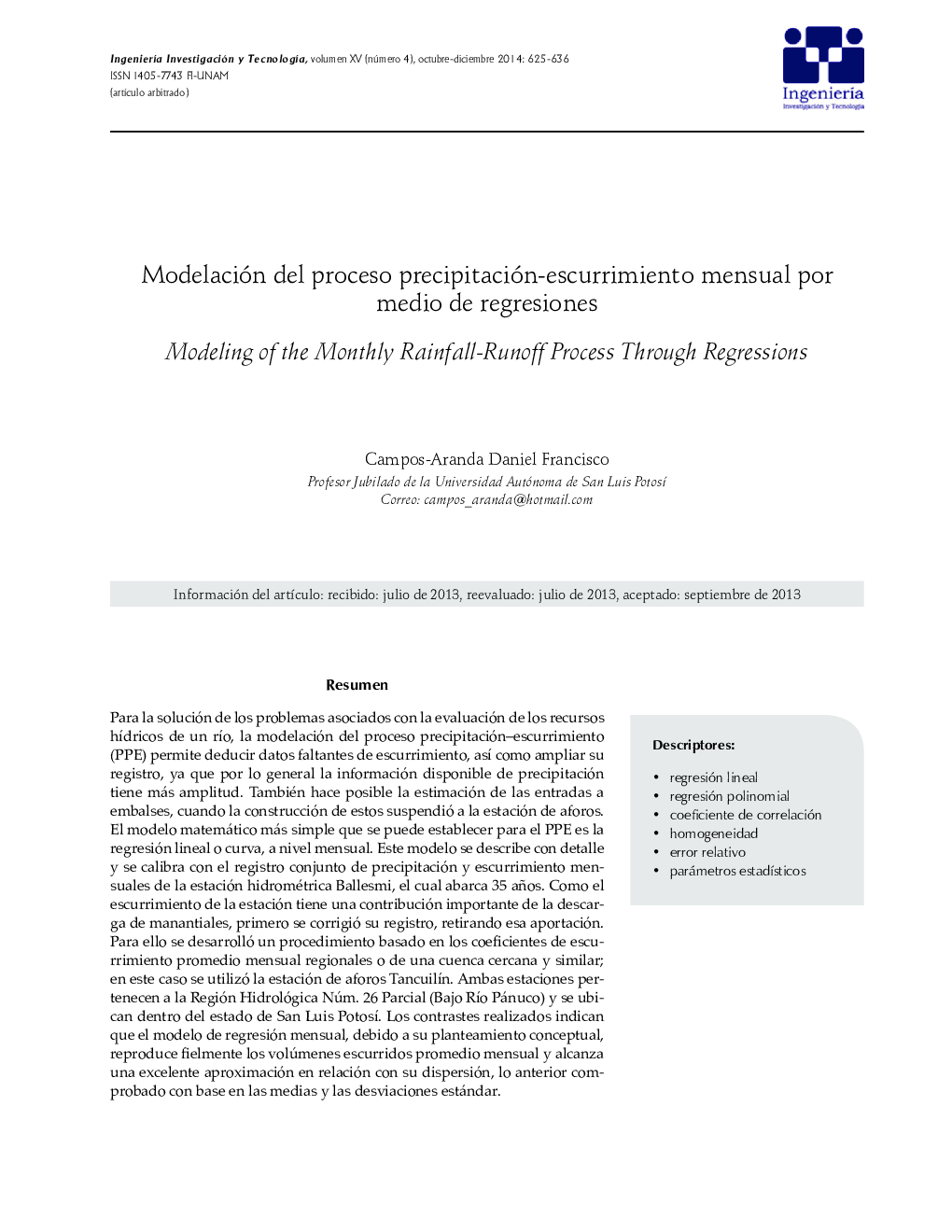| کد مقاله | کد نشریه | سال انتشار | مقاله انگلیسی | نسخه تمام متن |
|---|---|---|---|---|
| 274967 | 505388 | 2014 | 12 صفحه PDF | دانلود رایگان |
ResumenPara la solución de los problemas asociados con la evaluación de los recursos hídricos de un río, la modelación del proceso precipitación–escurrimiento (PPE) permite deducir datos faltantes de escurrimiento, así como ampliar su registro, ya que por lo general la información disponible de precipitación tiene más amplitud. También hace posible la estimación de las entradas a embalses, cuando la construcción de estos suspendió a la estación de aforos. El modelo matemático más simple que se puede establecer para el PPE es la regresión lineal o curva, a nivel mensual. Este modelo se describe con detalle y se calibra con el registro conjunto de precipitación y escurrimiento mensuales de la estación hidrométrica Ballesmi, el cual abarca 35 años. Como el escurrimiento de la estación tiene una contribución importante de la descarga de manantiales, primero se corrigió su registro, retirando esa aportación. Para ello se desarrolló un procedimiento basado en los coeficientes de escurrimiento promedio mensual regionales o de una cuenca cercana y similar; en este caso se utilizó la estación de aforos Tancuilín. Ambas estaciones pertenecen a la Región Hidrológica Núm. 26 Parcial (Bajo Río Pánuco) y se ubican dentro del estado de San Luis Potosí. Los contrastes realizados indican que el modelo de regresión mensual, debido a su planteamiento conceptual, reproduce fielmente los volúmenes escurridos promedio mensual y alcanza una excelente aproximación en relación con su dispersión, lo anterior comprobado con base en las medias y las desviaciones estándar.
To solve the problems associated with the assessment of water resources of a river, the modeling of the rainfall-runoff process (RRP) allows the deduction of runoff missing data and to extend its record, since generally the information available on precipitation is larger. It also enables the estimation of inputs to reservoirs, when their building led to the suppression of the gauging station. The simplest mathematical model that can be set for the RRP is the linear regression or curve on a monthly basis. Such a model is described in detail and is calibrated with the simultaneous record of monthly rainfall and runoff in Ballesmi hydrometric station, which covers 35 years. Since the runoff of this station has an important contribution from the spring discharge, the record is corrected first by removing that contribution. In order to do this a procedure was developed based either on the monthly average regional runoff coefficients or on nearby and similar watershed; in this case the Tancuilín gauging station was used. Both stations belong to the Partial Hydrologic Region No. 26 (Lower Rio Panuco) and are located within the state of San Luis Potosi, México. The study performed indicates that the monthly regression model, due to its conceptual approach, faithfully reproduces monthly average runoff volumes and achieves an excellent approximation in relation to the dispersion, proved by calculation of the means and standard deviations.
Journal: Ingeniería, Investigación y Tecnología - Volume 15, Issue 4, October–December 2014, Pages 625–636
